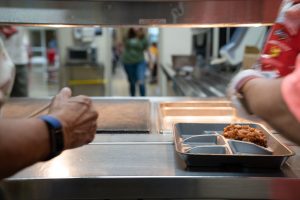News
Schools districts plead for universal lunch amid Ohio’s budget talks
By: Susan Tebben | Ohio Capital Journal
Posted on:
COLUMBUS, Ohio (Ohio Capital Journal) — Daryn Guarino had to tell a six-year-old girl she couldn’t eat lunch.

But his job isn’t so enjoyable on Wednesdays.
“On Wednesdays, I become a debt collections agent, and I chase the parents of families that have begun to accumulate lunch debt,” Guarino told an Ohio House Finance subcommittee on primary and secondary education.
Each week, he has to contact 250 families, about 1/3 of the student population at Alexander, a list that grows every week.
But if he doesn’t contact the families and do everything in his power to get the meal debt paid, he and his employees in the cafeteria will see the problem they all fear: the cash register will shut off for those students.
“The student will not be allowed any transactions at all,” Guarino said. “No food, nothing.”
His lunch workers have threatened to call in sick rather than tell a student they can’t eat, even donating money when they see a student’s debt getting close to the faultline.
So Guarino has to guide students out of the lunch line himself, and watch them gradually stop coming to the lunch room at all.
“Every day afterward, that student will quietly approach a register operator and ask if they can eat that day, and slink away if they can not,” Guarino said. “Eventually, they stop coming to the cafeteria all together.”
It’s a problem seen in many school districts across the state, and one administrators are begging legislators to fix as they discuss the education budget as a whole.
Tiffany McCleese, child nutrition director for the West Clermont Local School District, said her district has almost $22,000 in school meal debt, which causes distractions for school employees, but also the students themselves.
“We are working to provide sustenance so that our students, Ohio’s children, the future of Ohio, are ready and able to learn,” McCleese said. “It is difficult to do this when so many students are distracted by rumbling tummies.”
An issue of parental debt, even a “pride gap” from parents who know the stigma attached to free and reduced lunch, becomes a student problem, where they can’t eat the hot lunch of the day, or are faced with eating no lunch at all.
“Just like textbooks, Chromebooks and transportation, school meals are essential for student success,” said Alexis Weber, food service director for Austintown Local School in Mahoning County.
There is federal money to support part of the meal programs, including summer meals to cover the gap when students aren’t in school, and some districts have non-profit accounts that can cover meals, but ultimately, it’s state funding they need.
“With appropriate state funding to pick up where the federal funding falls short, school food service departments in our urban cities and in our rural counties could offer breakfast and lunch at no cost to all students, eliminating all the stigma that has perpetuated for decades around school meal benefits,” Weber said.
Universal breakfast and lunch programs have the support of a majority of Ohioans, according to a Baldwin Wallace poll of parent priorities when it comes to education.
In the poll, 87% of parents said meals should be provided without regard for the student’s ability to pay for the food.
The COVID-19 pandemic also inadvertently served as a pilot program for universal lunches, as school districts took it upon themselves to send food home to students as they learned in online classrooms.
The concept of giving all students free meals regardless of income could also give a boost to farmers around the state as well, as some districts already work with local food producers to bring nutritional meals to their students, according to Weber.
By reducing the burden on parents to think about lunch, the stigma that comes with students who are easily identified as free lunch kids can also be removed, taking away a stressor for students as well as getting the food they need.
“We demand that kids be in school, away from their parents for six hours per day and then, for some reason, we refuse to feed them while they are there,” Guarino said.
To combat the “pride gap” and the stigma, Guarino said it would be better to require all families to apply for assistance, regardless of income level.
“I’d prefer that parents had a mandatory form that they had to fill out, so I wouldn’t have to chase them around,” Guarino said. “Because I know a lot of them would qualify and it wouldn’t be an issue.”
As the legislature debates the merits of private school funding, public school funding, and everything involved in education, school administrators say hunger should be a no-brainer. While increasing the annual income eligibility for free or reduced lunch – the cutoff is currently about $51,000 for a family of four – eliminating the need to pay at all would be the best solution, the school districts said.
“Who is more worthy of our tax dollars than our children?” Guarino said.

